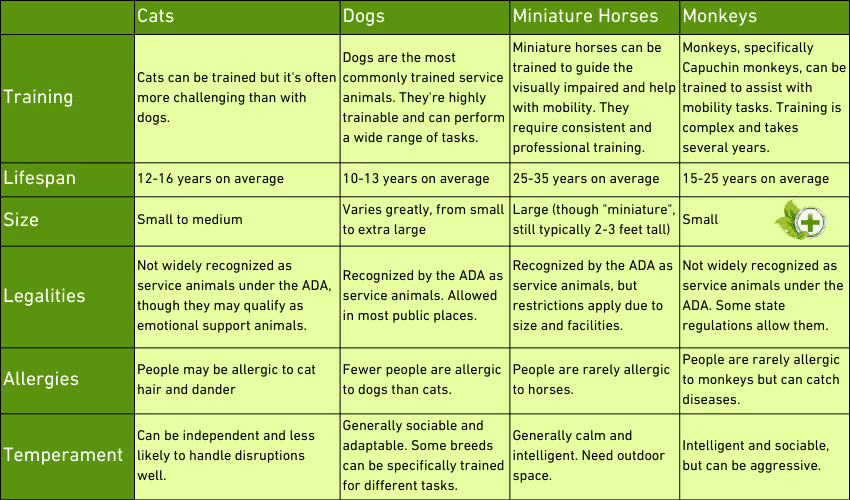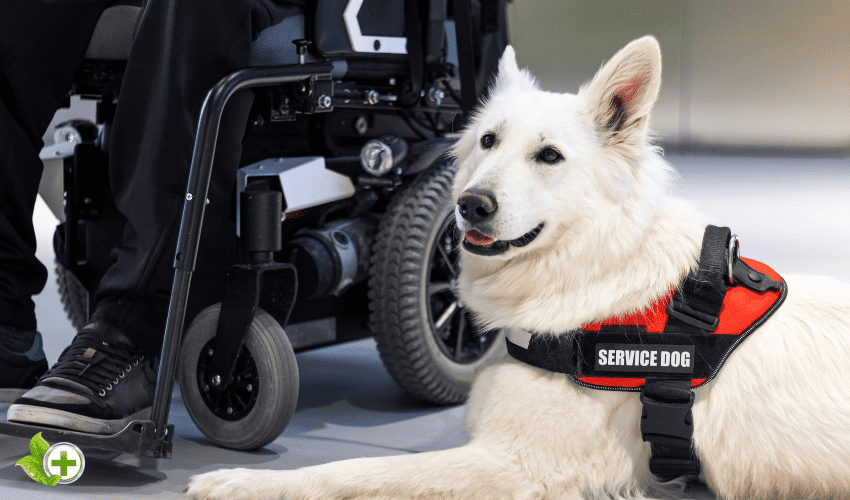Quick Reference
Can Cats Be Service Animals?
No. Service animals are limited to dogs and miniature horses.
The Americans with Disabilities Act of 1990 (ADA) defines a service animal as "an animal that has been trained to do work or perform tasks for the benefit of an individual with a disability, including a physical, sensory, psychiatric, intellectual, or other mental disability."
Why Can't Cats Be Service Animals?
- Cats Are Not As Easy To Train As Dogs
- Cats Are Not As Predictable As Dogs
Can Cats Be Emotional Support Animals?
Yes. Cats can be used as emotional support animals (ESAs).
- How Do I Make My Cat A Emotional Support Cat?
If you want to make your cat an emotional support animal, you will need a letter from one of your state's licensed mental health professionals. This letter must state that you have an emotional or mental disability and that the animal provides you with therapeutic benefits.
- Can My Therapist Write An Esa Letter?
Yes, your therapist can write you an ESA letter if he is a licensed mental health professional treating mental health issues.
- Do I Need A Specific Type Of Cat?
No, you do not need a specific type of cat to be an emotional support animal.
- Do I Need To Train My Cat to be an ESA?
No, you don't need to train your cat to be an ESA. An ESA is a pet that provides emotional support to its owner. Any domesticated animal can serve as an ESA.
- Can I Train My Cat To Be A Therapy Cat?
Yes, you can train your cat to be a therapy cat. Unlike service animals, therapy animals are not required to perform any specific tasks. A therapy animal's main goal is to provide emotional assistance to persons in need.
Difference Between Emotional Support Animals And Therapy Pets
Emotional Support Animals provide companionship and emotional support for their owners, who have a qualifying disability.
Therapy Pets provide affection and comfort to people in hospitals, nursing homes, schools, and other facilities. They are not considered service animals and therefore do not have the same legal rights as ESAs.
How To Train Your Cat To Be A Therapy Cat
- Start when they are young
- Expose your cat to positive interactions such as being handled, petted and groomed with treats or rewards for good behavior
- Teach simple commands such as sit, come and stay consistent with verbal cues
- Then hand signals or both so that your cat can easily recognize what action is expected from him/her
- Acclimate your cat to different therapy locations
Listen to the short audio
Cats and dogs have long been furry friends of humans, yet we still see only dogs as service animals. In public places like restaurants and on airplanes, we often see service dogs accompanying their owners, but have you ever seen a cat acting as a service cat?
We've seen numerous news about cats being able to save their owners by doing unexpected tasks like driving their owners' wheelchairs, calling 911, bringing their owner's phones when needed, etc. So can cats be service animals?
What is a service animal?
A service animal is described under the Americans with Disabilities Act (ADA) as a dog that has been individually taught to do work or perform duties for a person with a disability. The dog's task(s) must be directly tied to the person's impairment. [1]
A service animal is not a pet; it is a working animal. The work or tasks performed by a service animal must be directly related to the person's impairment. Under the ADA, dogs whose main purpose is to provide comfort or emotional support do not qualify as service animals.
This means that only dogs (except for miniature horses) can be service animals according to the ADA. However, a few states have laws allowing other animals to be considered service animals.
Did you know?
Cats love to sleep a lot! They usually snooze for about 16 hours every day, so to learn more we recommend reading 6 Reasons As To Why Do Cats Sleep So Much.

Can cats be service animals?
Short video
While the ADA only recognizes dogs (except for miniature horses) as service animals, some states have laws allowing other animals to be considered service animals. For example, Maryland law does not limit what types of animals can be considered service animals. A government website article, Service Animals, confirms that in some states, cats can be considered service cats.
However, most states still only recognize dogs as service animals. This means that, in most cases, cats cannot be considered service cats.
Some requirements must be met if you live in a state that allows for other animals to be considered service animal. The animal must be specifically trained to do work or perform tasks to benefit a person with a disability. The animal must also be under the handler's control at all times.
So, while a cat can be considered a service animal in some states, it is still relatively rare.
Why can't cats be service animals?
There are a few reasons why cats are not used as service cats.
Cats are not as easy to train as dogs
For centuries, dogs have been bred to work alongside humans. They are natural companions and are very good at following commands.
Cats, on the other side, have never been bred to work with humans. They are independent creatures that often do not take well to training. This makes them less ideal as service animals.
According to a study of Clicker Training for Shelter Cats published in the National Library of Medicine, out of 100 cats, only 79% of cats learned the ability to touch a target, 27% learned sitting, 60% learned spinning, and 31% learned to high-five. [2]
On the other hand, dogs can learn these same tasks within about two days. [3]
This difference in training ability is one of the main reasons cats are not used as commonly as service cats.
Cats are not as predictable as dogs
Another reason cats aren't used as service animals more commonly is that they aren't as predictable as dogs.
Dogs have been bred to be predictable creatures. They have a natural desire to please their owners and follow commands.
Cats, on the other side, are not as predictable. They often do not respond well to training and can be less responsive to commands. Cats can be aggressive toward their owners if the owner can't predict the cat's emotional/motivational state. [4]
This lack of predictability makes cats less ideal as service cats.
There are exceptions to this since certain cats have been shown to be clever enough to serve as assistance animals. For example, a domestic cat saved an 80-year-old man from dying alone after a fall in the bathroom by bringing his phone following the owner's command. You can read more about this by watching Cat Saves Man's Life After Fall. Yet, the law doesn't seem to be changing anytime soon, so for now, it seems that cats will remain fairly uncommon as service animals.

What animals can be service animals?
ADA only recognizes dogs and sometimes miniature horses as service animals, but some states have laws allowing for other animals to be considered service animals.
Dogs are the most common service animal, but a few other animals can be considered service animals in SOME states. (Check above)
These include:
- Cats
- Pigs
- Birds
- Rabbits
- Ferrets
However, this doesn't mean you can bring these animals as service animals to other states. Each state has different laws regarding service animals, so it is important to check the laws of the state you are in before bringing any animal into a public place.
In the case of service dogs, you can bring them anywhere with you as they are federally protected. However, it is not the case for other animals that might be considered service animals in some states.
Can cats be emotional support animals?
While cats are not commonly used as service animals, they can be used as emotional support animals (ESAs).
An emotional support animal is a pet that offers comfort to persons suffering from mental or emotional disorders. According to the Department of Human Rights, any type of animal can be an emotional support animal. [5]
This means that cats, as well as other animals, can be used as emotional support animals.
Unlike service animals, Emotional Support Animals (ESAs) do not have to be trained to perform any specific tasks.
The main initiative of an ESA is to provide emotional support to its owner.
ESAs are not protected under the ADA, but they are protected under the Fair Housing Act (FHA). [6]
The Fair Housing Act forbids landlords from discriminating against disabled tenants. This means landlords must make reasonable accommodations for tenants who use ESAs.
Some examples of reasonable accommodations include:
- Allowing a tenant to have an ESA despite a no-pets policy
- Waiving pet fees for tenants with Emotional Support Animals
- Allowing the tenant to have a larger ESA than what is normally allowed
Important: Is your potential service cat snoring? Discover the underlying reasons and solutions in our detailed post, Reasons For Cat Snoring And What You Can Do.
How do I make my cat an emotional support cat?
If you want to make your cat an emotional support animal, you will need a letter from one of your state's licensed mental health professionals. This letter must state that you have an emotional or mental disability and that the animal provides you with therapeutic benefits.

Can my therapist write an Esa letter?
Your therapist can write you an ESA letter if he is a licensed mental health professional treating mental health issues.
If you are unsure, just ask your mental health provider if he or she can write you an ESA letter.
Do I need a specific type of cat?
No, you do not need a specific type of cat to be an emotional support animal. Any type of cat can be an emotional support animal.
However, some cat breeds are proven to be more affectionate than others.
The following are some of the most affectionate cat breeds:
- Siamese
- Ragdoll
- Birman
- Persian
- Sphynx

Do I need to train my cat to be an ESA?
No, you do not need to train your cat to be an emotional support cat.
The main goal of an emotional support animal (ESA) is to provide emotional support to its owner. Training of your cat is not required, but it is recommended.
A well-trained emotional support cat will be better behaved in public and will be less likely to cause problems for you or your landlord.
Some basic training commands that you may want to teach your emotional support cat include:
- Sit
- Stay
- Come
- Down
- Off
- Leave it
These are just a handful of the commands your emotional support cat can learn. It is entirely up to you to determine which instructions to teach your cat.
Can I train my cat to be a therapy cat?
Yes, you can train your cat to be a therapy cat. Therapy cats provide comfort and companionship to people in hospitals, nursing homes, and other settings.
Unlike service animals, therapy animals are not required to perform any specific tasks. A therapy animal's main goal is to provide emotional assistance to persons in need.
Felines can serve as a;
- Animal-Assisted Therapy (AAT) or/and
- Animal-Assisted Activities Therapy (AAAT) animal.
Difference between emotional support animals and therapy pets
An emotional support animal is an animal that provides therapeutic benefits to an individual with a mental or emotional disability.
A therapy pet is a pet that provides therapeutic benefits to people in hospitals, nursing homes, and other settings.
Therapy pets are not required to perform any specific tasks.
How to train your cat to be a therapy cat?
The best way to train your cat to be a therapy cat is to start socializing with them at a young age. You can do this by taking them to places where they will be around people, such as the park or pet store.
It is also important to desensitize your cat to common stimuli, such as loud noises, so they will not be easily scared or overwhelmed in therapy.
You can begin training your cat to be a therapy cat by teaching them basic obedience commands, such as sit, stay, come, down, off, and leave it. You should also teach your cat how to behave around people, such as not to scratch or bite.
Once your cat is comfortable around people and has basic obedience training, you can begin taking them to therapy sessions.
You will have to register your pet as a therapy cat under a valid organization like the American Kennel Club (AKC) or the Cat Fanciers' Association (CFA).
You may also need to get liability insurance for your therapy cat as they might injure someone while working.
Pro Tip: Considering a Siamese Ragdoll as a service cat? Understand their temperament and health with our in-depth guide, Your Ultimate In-Depth Guide To The Siamese Ragdoll Cat.
Conclusion
Although it's not fair, cats can't be service animals. However, they can serve you as emotional support cats and therapy cats if you train them. Emotional support cats do not require any special training, but therapy cats do.
FAQ
How Much Does It Cost To Make My Cat An Emotional Support Animal?
There is no cost to making your cat an emotional support animal. You only need a licensed mental health practitioner statement saying that you have a mental or emotional disability and that your cat provides you with emotional support. However, some organizations provide online ESA registrations for a fee of about $100 to $200.
Can A Cat Help With Mental Health?
Yes, a cat can help with mental health. Cats have been shown to reduce stress and anxiety levels in people. They can also provide companionship and unconditional love.
References
- ADA.gov: Service Animals
- National Library of Medicine: Assessment of Clicker Training for Shelter Cats
- NLH: Conditioning shelter dogs to sit
- NLH: Unanswered Questions and Hypotheses about Domestic Cat Behavior, Ecology, and the Cat–Human Relationship
- Minnesota Department of Human Rights: Service and Emotional Support Animals
- Dfeh: Emotional Support Animals and Fair Housing Law FAQ
Disclaimer
The information provided on this blog is for informational purposes only and is not intended as a substitute for professional medical advice. Always consult with your doctor or other qualified healthcare provider before making any changes to your health regimen. The author of this blog is not a medical professional and does not claim to be able to diagnose or treat any medical conditions. The information provided on this blog is based on the author's own research and experience, and should not be taken as medical advice.
The author of this blog assumes no responsibility for any errors or omissions in the information provided. The information on this blog is provided on an "as is" basis, and the author does not make any guarantees about its completeness, accuracy, usefulness, or timeliness.







